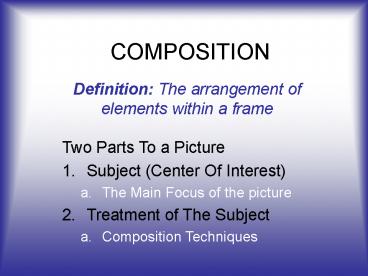COMPOSITION - PowerPoint PPT Presentation
1 / 37
Title: COMPOSITION
1
COMPOSITION
- Definition The arrangement of elements within a
frame
- Two Parts To a Picture
- Subject (Center Of Interest)
- The Main Focus of the picture
- Treatment of The Subject
- Composition Techniques
2
COMPOSITIONTechniques
- 8 Elements of Composition
- Rule of Thirds
The Subject of the Photograph should be off
center in the frame
3
COMPOSITIONTechniques
- 8 Elements of Composition
4
(No Transcript)
5
COMPOSITIONTechniques
- 8 Elements of Composition
- Rule of Thirds
Horizon Rule Horizon Line should be placed in the
top or bottom third of the frame
6
Horizon Rule Top or Bottom 3rd
7
COMPOSITIONTechniques
- 8 Elements of Composition
- Background
Always be aware of your background. It should
never interfere with your subject and your message
8
Background
Background interferes, competing with the subject
for attention.
Background complements and strengthens the
subject.
9
The Aperture is the camera control that
directly affects background focus, which we call
Depth of Field
10
COMPOSITIONTechniques
- 8 Elements of Composition
- Background
Avoid Mergers. Because photos are 2 Dimensional,
objects directly behind other objects in the
frame can appear to merge together.
11
(No Transcript)
12
COMPOSITIONTechniques
- 8 Elements of Composition
- Balance
Always try to achieve a sense of Balance in the
shot
13
COMPOSITIONTechniques
- 8 Elements of Composition
- Balance
- Two kinds of balance
- Symmetrical Balance (equal)
- Asymmetrical Balance (unequal)
14
Balance
Asymmetrical Balance
Asymmetrical Balance
Symmetrical Balance
15
COMPOSITIONTechniques
- 8 Elements of Composition
- Lines
Lines can psychologically charge your image. We
react differently to different kinds of lines
16
COMPOSITIONTechniques
- 8 Elements of Composition
- Lines
- Horizontal and Curved Lines create a sense of
calm or peace - Diagonal or Vertical lines create a sense of
tension
17
Curves create peacefulness or a sense of calm, as
opposed to the tension that diagonals can create
18
Lines, Shapes, Repetition, Pattern
Pay attention to what Lines can do to create
shapes, repetition, and patterns in a photo. All
of these also add interest to a composition
19
COMPOSITIONTechniques
- 8 Elements of Composition
- Lines
- Leading Lines unconsciously lead the viewers eye
to the vanishing point. Photographers will often
place the subject of the shot at the vanishing
point so the eye is forced to focus there
20
(No Transcript)
21
COMPOSITIONTechniques
- 8 Elements of Composition
- Perspective
The Perspective is the angle of view of the
photo. Like lines, angles can psychologically
affect the viewer (besides just making a shot
more interesting generally)
22
COMPOSITIONTechniques
- 8 Elements of Composition
- Perspective
- A High Angle gives the subject a feeling of
weakness or inferiority - A Low Angle gives the subject a feeling of
strength or dominance
23
High Angle
Low Angle
Inferiority or Weakness
Dominance or Strength
24
Perspective (angle of view)
25
COMPOSITIONTechniques
- 8 Elements of Composition
- Framing
Using objects in the Foreground to naturally
frame your subject
26
Framing is used to add interest to a photograph
and to add a 3 Dimensional feel to the shot
27
(No Transcript)
28
COMPOSITIONTechniques
- 8 Elements of Composition
- Motion
Motion is directly controlled by the cameras
shutter speed
29
COMPOSITIONTechniques
- 8 Elements of Composition
- Motion
- Fast shutter speeds freeze motion
- Slow shutter speeds blur motion
30
(No Transcript)
31
Motion
Motion Freeze
Motion Blur
32
Rule of Motion
Movement should be placed in the frame so it is
coming into, not leaving, frame.
33
Rule of Motion
As with most everything, there are exceptions to
the rule.
In this case, because the shot includes visual
elements that work directly with the subject (the
lines connecting the person in the background to
the lines from the subjects action), framing the
shot as seen is ok
34
COMPOSITIONTechniques
- 8 Elements of Composition
- Light
- Light is perhaps the most important element in
photography as everything depends on it - Things to Remember
- Light source should be behind the photographer
- Overhead Light is harsh and flat (best time to
take photos is morning or evening) - Direct Flash is harsh and flat and can blow out
details - Try to use bounce, reflected, or diffused light
35
- Light
MOTION BLUR using a Slow Shutter Speed at Night
36
- Light
Light Trails from stars using a long shutter
speed (B or Bulb Setting)
37
- Light
Position of the light source creates different
effects such as silhouette from back lighting as
above or dramatic shadows from side lighting as
to the right































